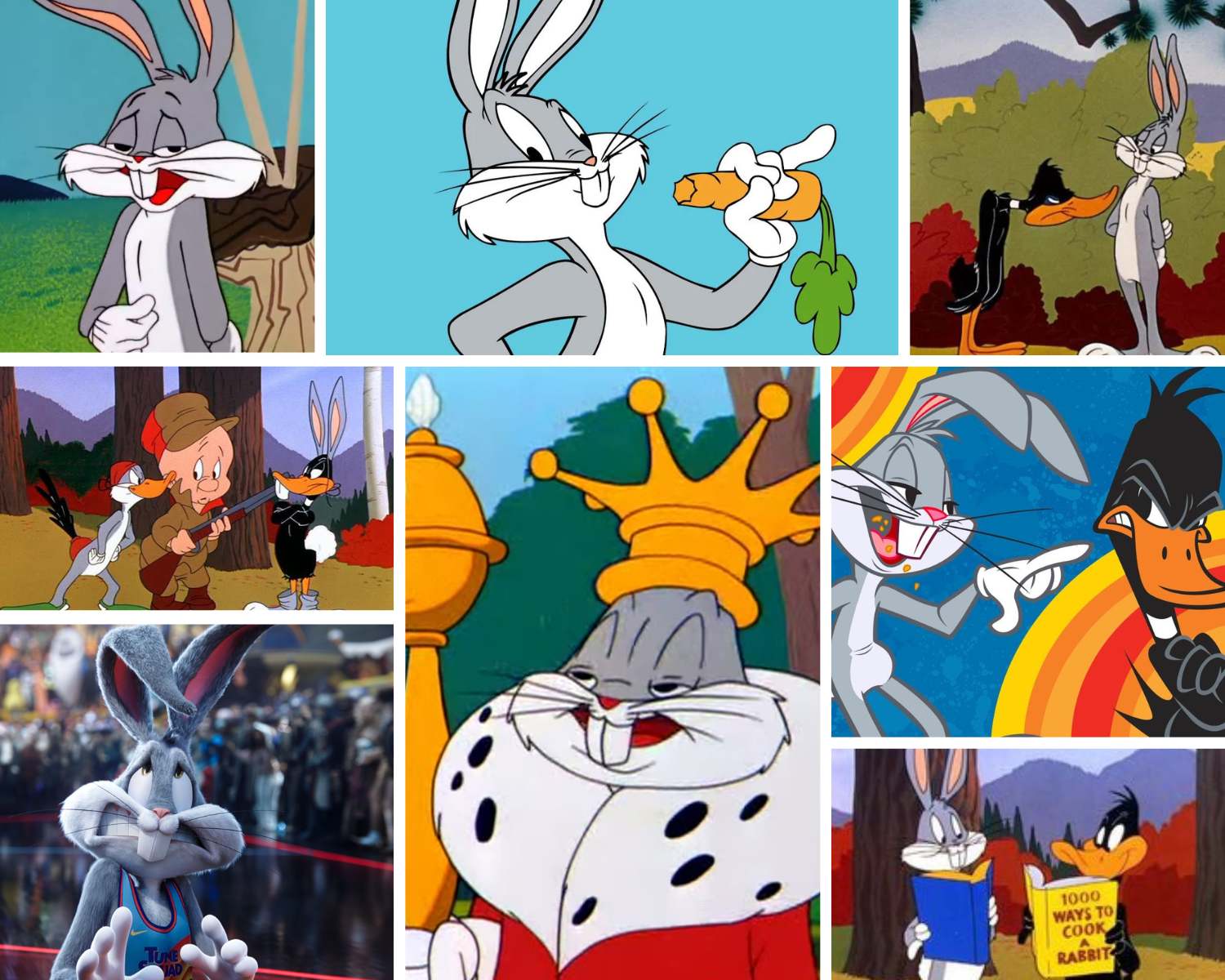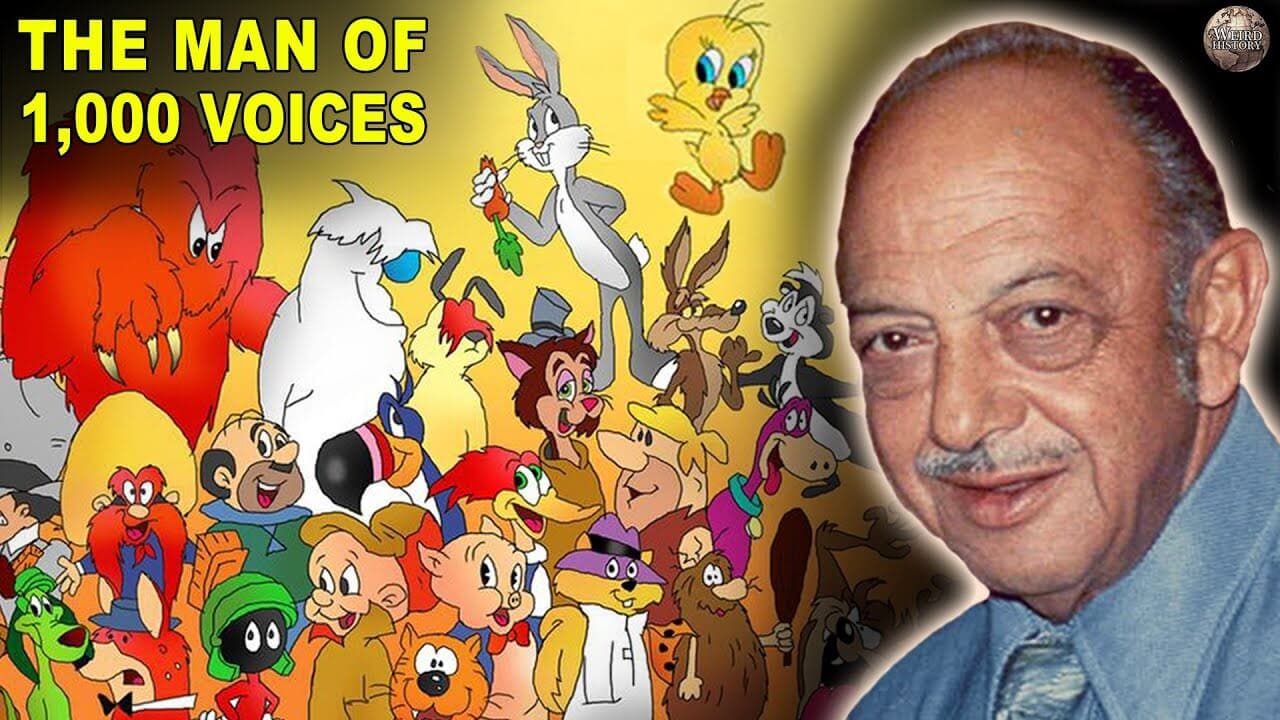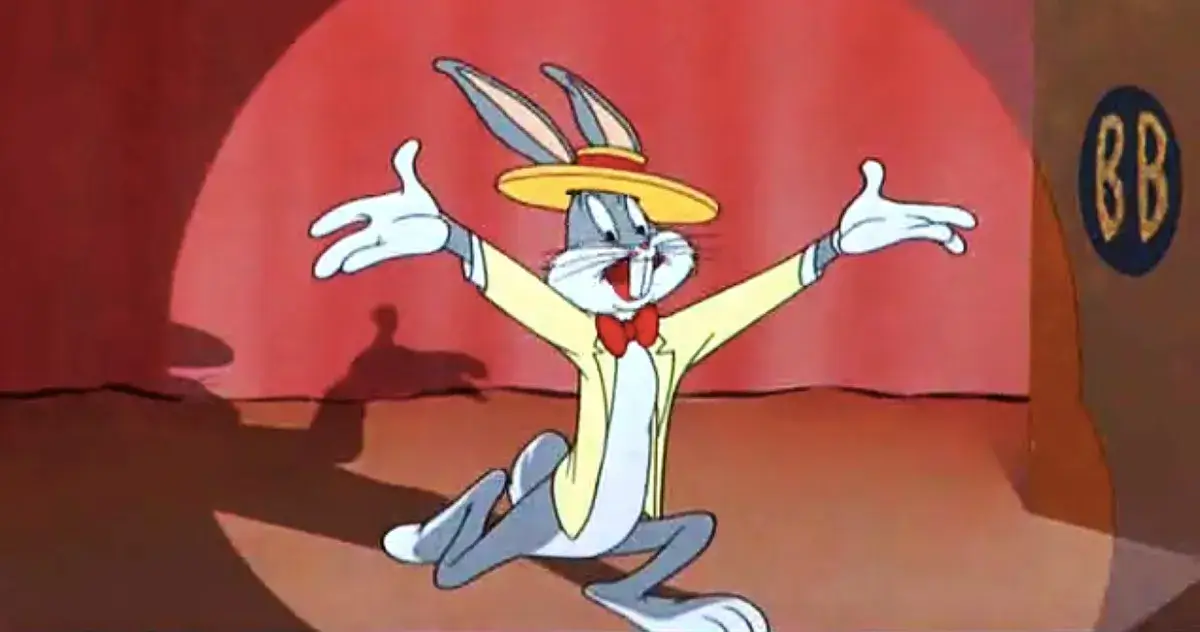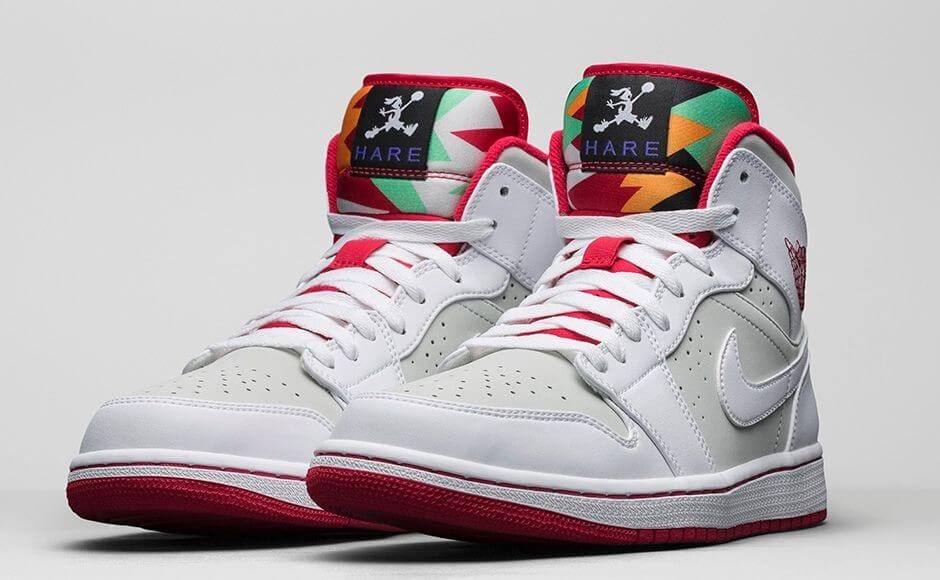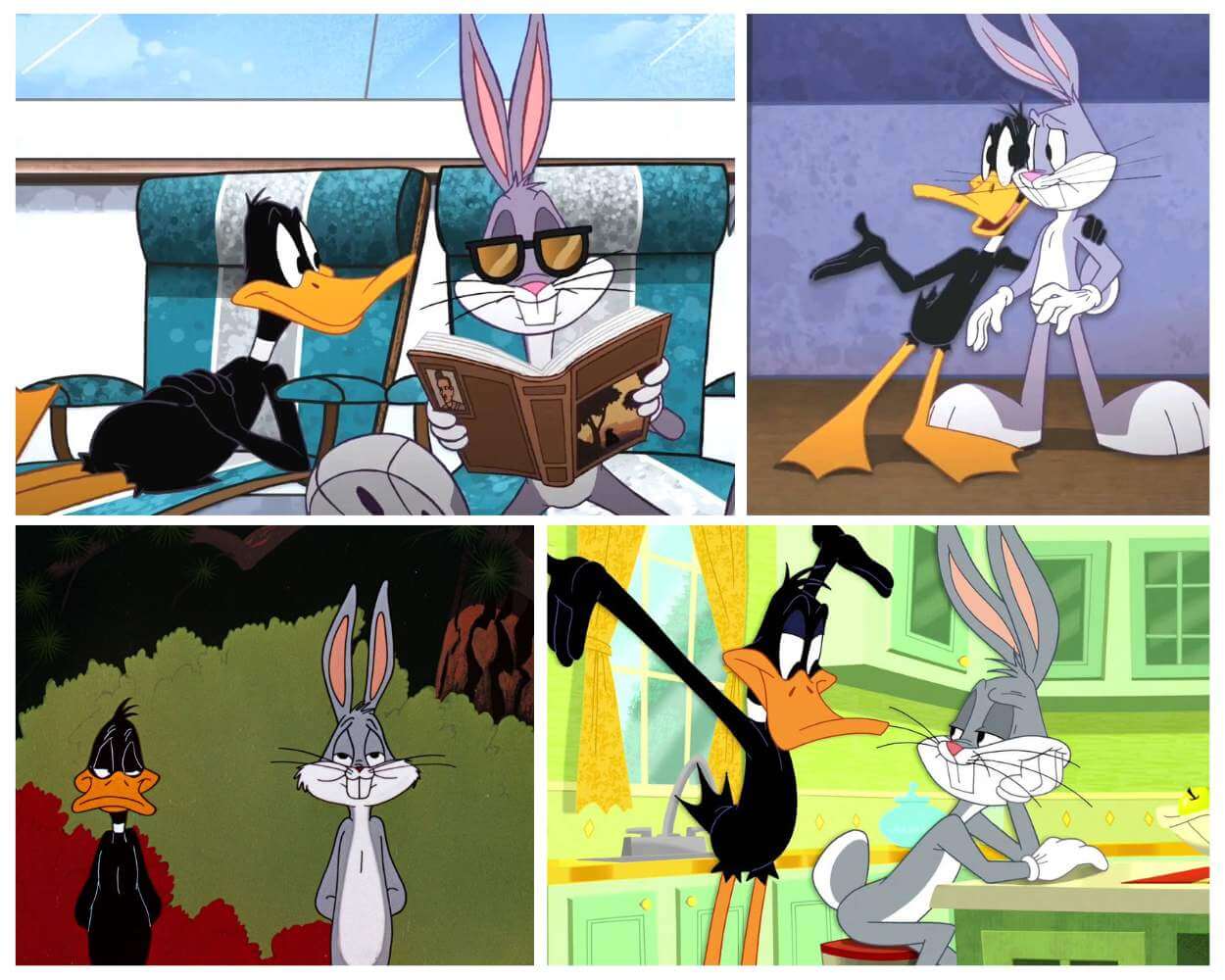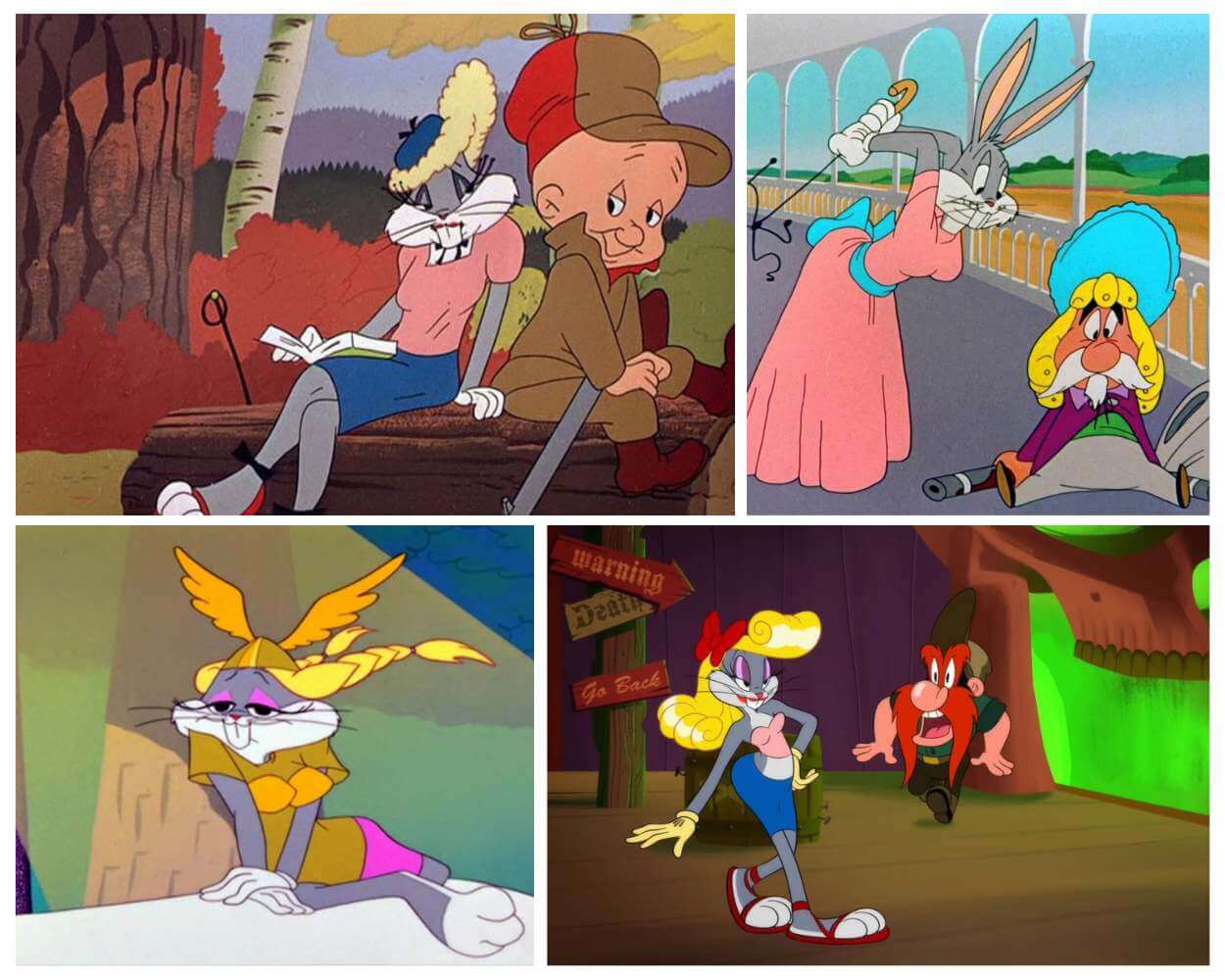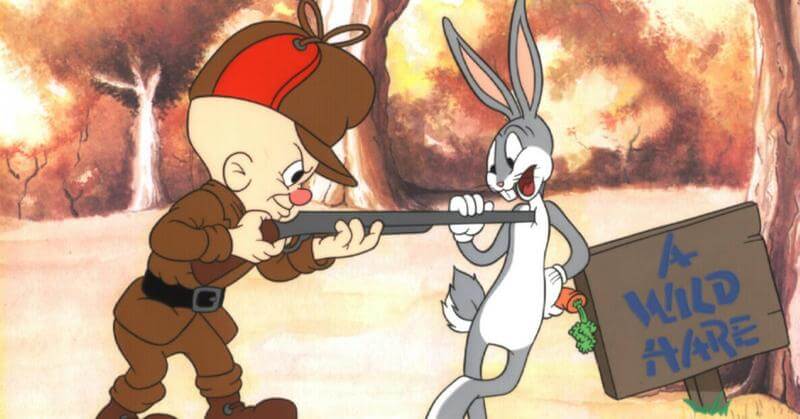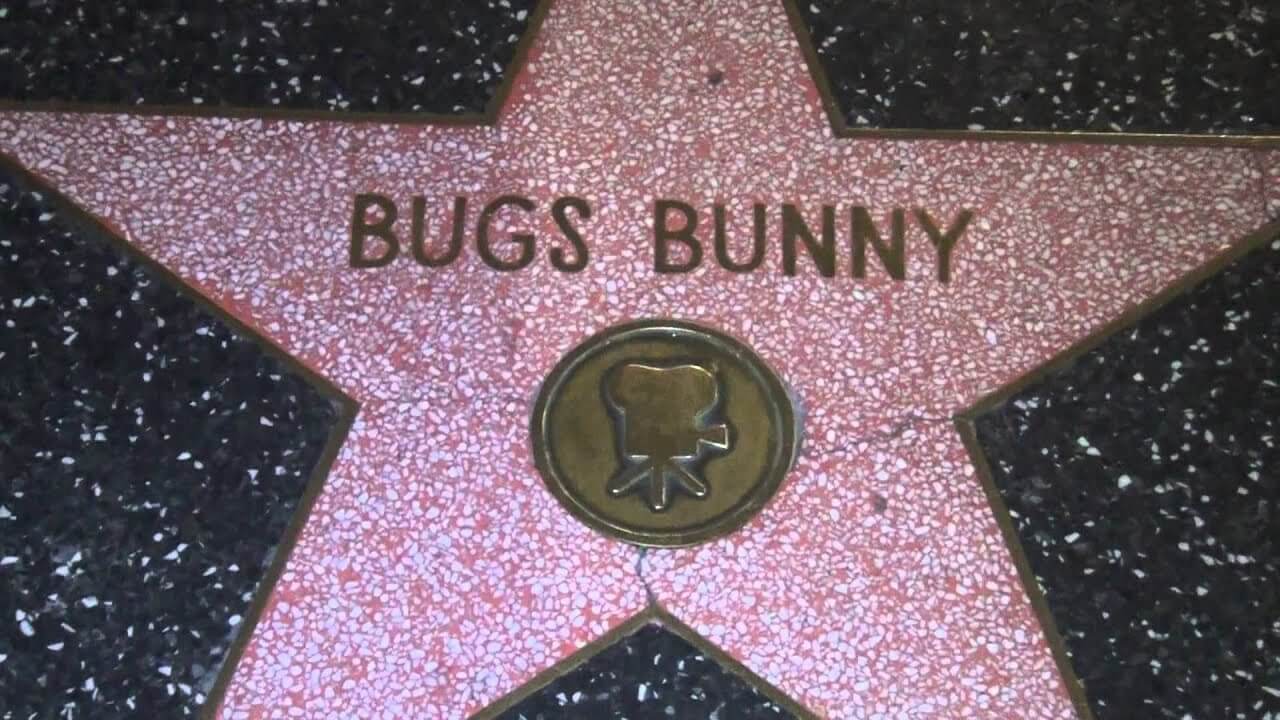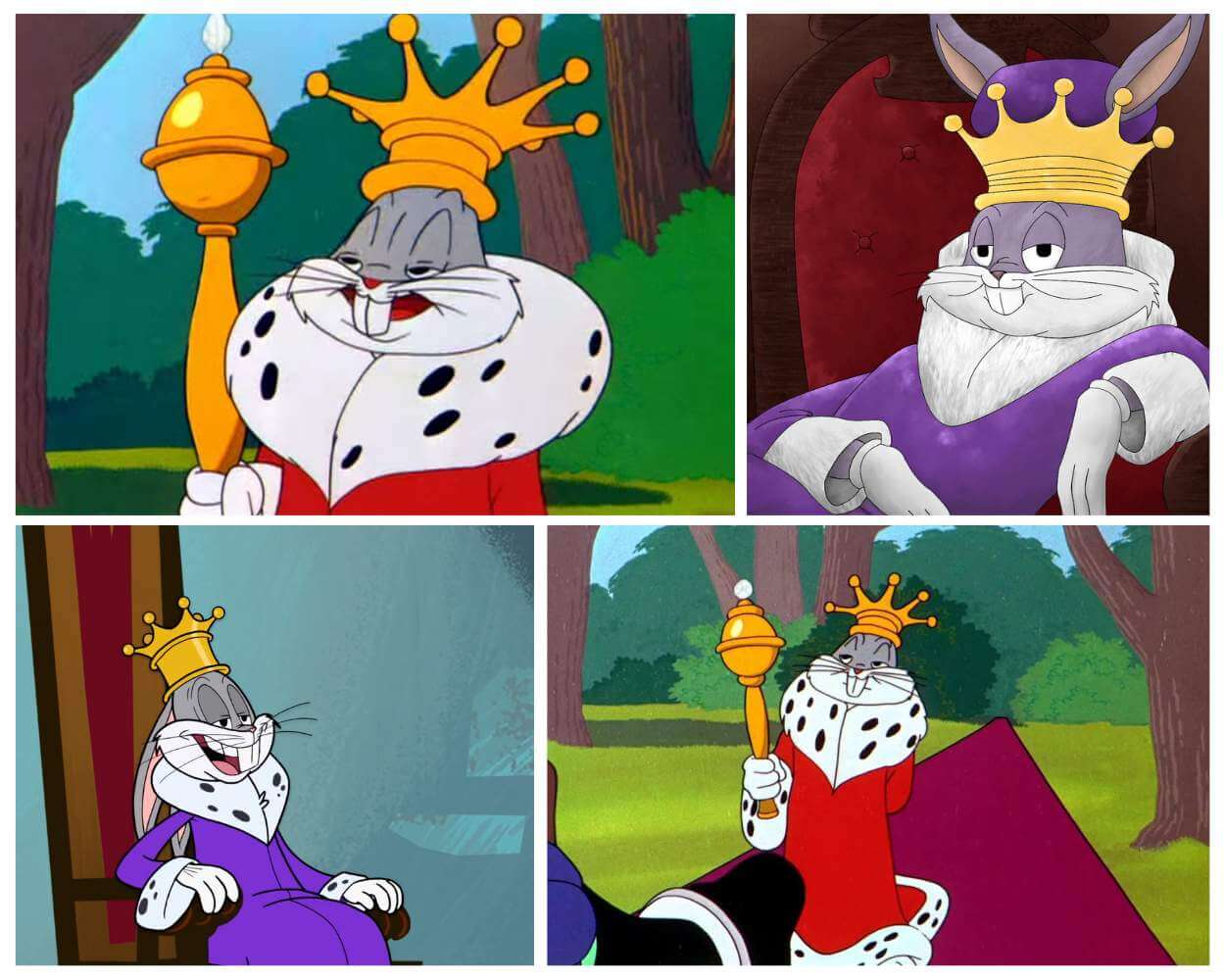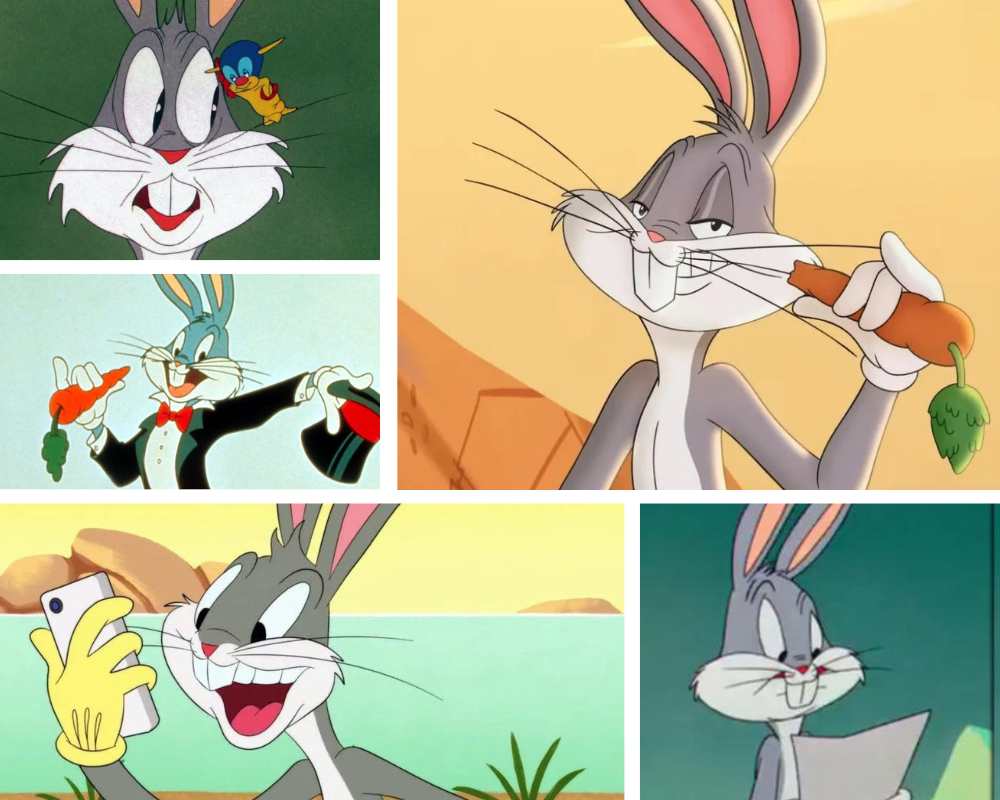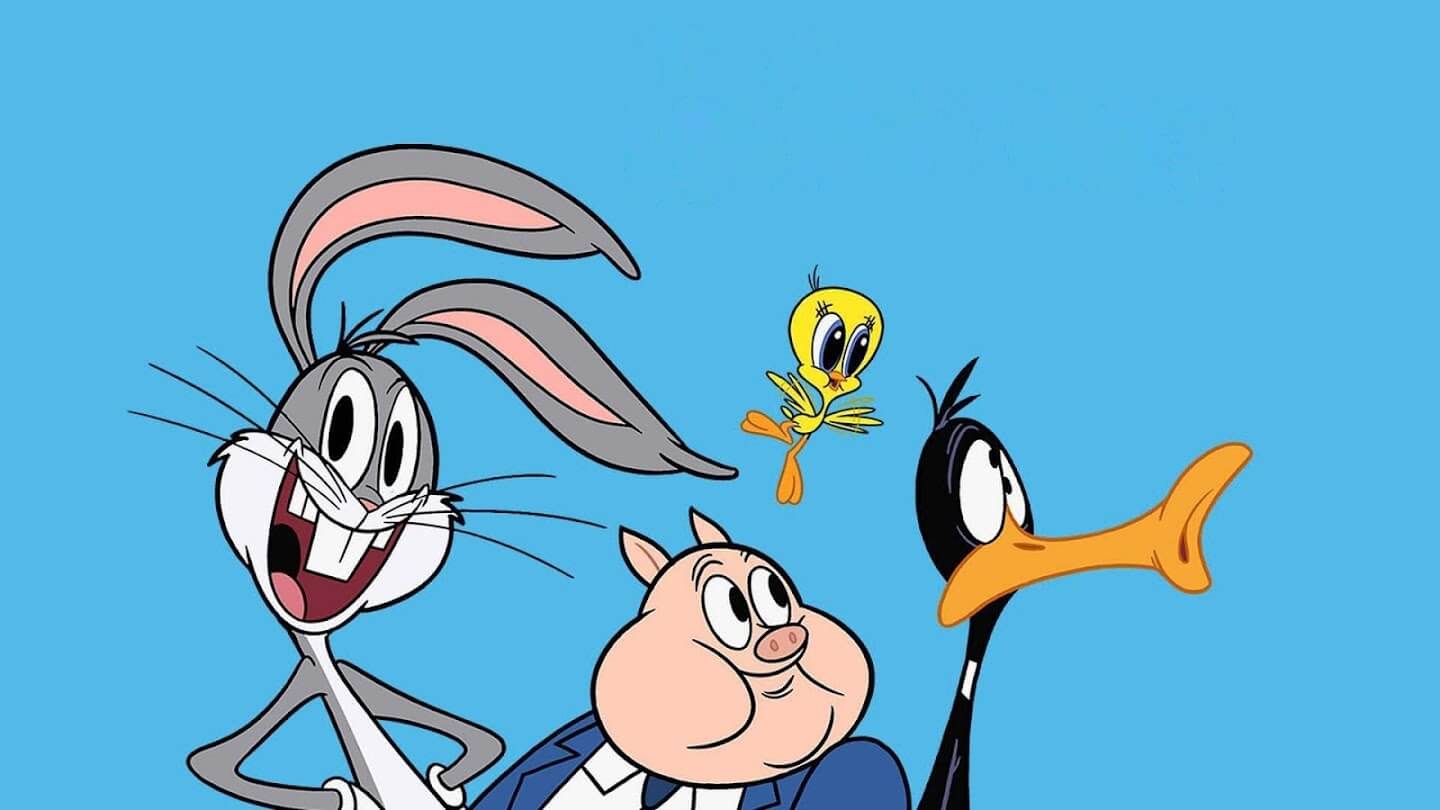Bugs Bunny was born out of the creative chaos at Warner Bros. Studios in the early 1940s. With an evolving design team, including the likes of Tex Avery, Bob Clampett, and Chuck Jones, Bugs was forged in a crucible of genius.
His first official appearance was in a short film, “A Wild Hare,” released on July 27, 1940. However, his character traits – a confident, chatty rabbit – were not fully formed until later iterations.
His unforgettable catchphrase, “Eh…What’s up, doc?” was supposedly inspired by Tex Avery’s Texas high school, where ‘doc’ was a casual term for addressing others. The phrase, now synonymous with the character, was first voiced by the legendary Mel Blanc in “A Wild Hare.”
The Fascinating World of Bugs Bunny
Bugs Bunny is no ordinary rabbit. He is a master of comedic chaos, a nonchalant trickster who always remains one step ahead of his adversaries, whether dimwitted hunters, wannabe conquerors, or disgruntled ducks.
From his official debut to his role during World War II and evolution over the years, Bugs Bunny has remained a beloved cartoon character.
Let’s take a deep look.
Creators: Chuck Jones, Tex Avery, Bob Clampett, Robert McKimson, Bob Givens
Origins Of Bugs Bunny
Gender: Male
Hair Color: Grey/White
Eye Color: Black
Species: Rabbit
Nationality: American
Studio Origin: Warner Bros. Animation
The birth of Bugs Bunny traces back to 1940, with the Merrie Melodies animated short “A Wild Hare,” directed by the talented Tex Avery. However, Bugs’ creation was collaborative, with contributions from an ensemble of creative minds. One of the most iconic features of Bugs Bunny is his grey hare fur, which has become synonymous with the character.
Bob Givens, Chuck Jones, and Friz Freleng, among others, worked diligently to fine-tune the rabbit’s design while the inimitable Mel Blanc lent his voice to the character. Another important contributor to the creation of Bugs Bunny was Ben Hardaway, who helped develop the character’s personality and mannerisms.
Interestingly, Bugs’ prototype was a white rabbit, but the team chose a gray color to ensure he would stand out against various backgrounds.
As they sketched and animated this rascally rabbit, little did they know that they were creating a pop culture icon for the ages.
The Voice that Echoes Through Time
Mel Blanc, the iconic voice actor, gained fame by associating with the mischievous wabbit. Born in San Francisco, California, on May 30, 1908, Blanc lent his voice to many other animated characters, such as Daffy Duck, Porky Pig, Tweety Bird, Sylvester the Cat, and more.
Blanc was also a Warner Bros. Symphony Orchestra member, where he played the violin and the sousaphone.
Blanc started his career in radio, but only after joining Warner Bros. and collaborating with Tex Avery and Chuck Jones did he become the legendary voice of Bugs Bunny. In the 1940 short film “A Wild Hare,” Blanc first voiced Bugs, introducing the character’s iconic catchphrase, “Eh, what’s up, doc?”
Walt Disney, a fan of Blanc’s work, later hired him to voice several characters in Disney productions.
Thanks to Mel Blanc’s distinct voice and comedic timing, Bugs Bunny came to life as one of the most beloved and recognizable animated figures in history. Until his death on July 10, 1989, Blanc continued voicing Bugs Bunny and other Looney Tunes characters.
Joe Alaskey later took over the role of Bugs Bunny and continued to bring the character to life with his own unique voice.
Name Origins Of Bugs Bunny
Several key players in the animation industry played a part in the interesting history of Bugs Bunny’s name. Warner Bros. developed the character during the late 1930s and early 1940s as part of their Looney Tunes and Merrie Melodies series.
Before Bugs Bunny’s official debut, early prototypes appeared in a few cartoons. In the 1938 short “Porky’s Hare Hunt,” a not-yet-fully-developed character similar to Bugs, a Small white rabbit, tormented Porky Pig.
Tex Avery directed Bugs Bunny’s first official appearance in the 1940 cartoon “A Wild Hare.” Avery refined the character’s design and personality, while Mel Blanc’s voice acting contributed to Bugs’ distinct persona.
Although not directed by Avery, Roger Rabbit, a character from the 1988 film “Who Framed Roger Rabbit,” was heavily influenced by Avery’s work and is often compared to Bugs Bunny.
The name “Bugs Bunny” reportedly originated from collaborating with various animators and storymen at the Warner Bros. studio.
Ben “Bugs” Hardaway, an animator and storyman, played a role in the character’s development. Animation lore suggests that the character’s name came from Hardaway’s nickname, “Bugs,” and even caught the attention of Hollywood legend Clark Gable, who reportedly sent a letter to Warner Bros.” praising the character’s name.
The Bugs Bunny Jordans 7 & 8
The popular collaboration between Nike’s Air Jordan brand and Warner Bros., known as the Bugs Bunny Jordans or the Air Jordan 7 “Hare,” features the iconic Bugs Bunny character. The shoe belongs to the Air Jordan line, a series of basketball sneakers endorsed by and named after NBA legend Michael Jordan.
In the early 1990s, Nike and Warner Bros. created an advertising campaign for the Air Jordan 7, starring Michael Jordan and Bugs Bunny. The ads achieved massive success, leading to the nickname “Hare Jordan” for the Jordan-Bugs duo, a play on words with “Air Jordan.”
First released in 1992, the Air Jordan 7 “Hare” sported a white and light silver colorway with red, green, and gold accents, drawing inspiration from Bugs Bunny’s colors.
The shoe’s tongue featured a unique pattern resembling the character’s fur, while the heel displayed the number “23,” representing Michael Jordan’s jersey number.
Distinct Character Personality
Bugs Bunny’s distinct character personality shines through in his cleverness and quick thinking in tricky situations. Fans of all ages are drawn to his mischievous nature and sense of humor, making him a beloved cartoon character. His laid-back and carefree attitude only adds to his charm and likability.
Bugs Bunny often outsmarts his foes with his wit and cunning, making him a true hero in every adventure he embarks on. And, of course, who can forget his famous catchphrases like “What’s up, doc?” and “Ain’t I a stinker?” These iconic lines have become synonymous with the looney tunes bunny, making him a household name in animation.
Bugs Bunny’s distinct personality has solidified his place as a timeless and enduring character in the hearts of fans around the globe.
Famous Catchphrases
Bugs Bunny, the iconic cartoon character, has left a lasting impact on pop culture with his famous catchphrases. One of his most well-known lines is “What’s up, doc?” Bugs Bunny often uses this catchphrase to greet others or express curiosity.
Another playful catchphrase of his is, “Eh, what’s cookin’?” It’s his way of asking what someone is up to or what they’re planning. Bugs Bunny also has a cheeky remark, “Ain’t I a stinker?” which he says after pulling off a clever prank or tricking his adversaries.
And when Bugs Bunny is ready for a comical battle, he declares, “Of course you know, this means war!” Lastly, when things don’t go as planned, or he finds himself in unexpected situations, Bugs Bunny humorously exclaims, “I knew I should’ve taken that left turn at Albuquerque!”
These famous catchphrases have become synonymous with the charm and wit of Bugs Bunny, solidifying his status as an enduring and beloved cartoon character in the golden age of American animation.
Lola Bunny – Bugs Bunny’s Girlfriend
Bugs Bunny’s girlfriend, Lola Bunny, is a popular character in the Looney Tunes franchise. She first appeared in the 1996 live-action/animated film “Space Jam,” starring Michael Jordan and various Looney Tunes characters in a basketball-themed adventure. The creators introduced her as a female counterpart and love interest for Bugs Bunny in the film.
Lola Bunny’s portrayal showcases her as a smart, athletic, and confident character. Excelling in basketball, her skills on the court play a crucial role in the film’s climax. Bugs Bunny becomes obsessed with her throughout the movie, leading to a flirtatious subplot. Lola embodies independence and self-assuredness, demanding respect from fellow Looney Tunes characters.
Over the years, Lola Bunny’s design has undergone various changes. In “Space Jam,” her initial appearance depicted her as a curvy and somewhat sexualized character.
Bugs Bunny and Daffy Duck – Friends or Foe?
Bugs Bunny and Daffy Duck, two of the most iconic characters in the Looney Tunes franchise, are not best friends in the traditional sense. They often appear as frenemies, engaging in comedic and competitive interactions.
Their love-hate dynamic has them constantly trying to outsmart each other while occasionally teaming up against a common enemy.
In most Looney Tunes cartoons, Bugs Bunny and Daffy Duck don’t typically live together. However, “The Looney Tunes Show” (2011-2014), an animated sitcom set in a modern suburban setting, depicts Bugs and Daffy as housemates who share a home and experience everyday misadventures.
The on-screen chemistry and rivalry between Bugs Bunny and Daffy Duck have made them a popular duo in animation history. They have appeared together in numerous classic cartoons, often competing against each other or other characters like Elmer Fudd or Yosemite Sam.
The compelling dynamic between Bugs Bunny’s calm, witty demeanor and Daffy Duck’s impulsive, attention-seeking personality has entertained audiences for decades.
Bugs Bunny in Drag
In several Looney Tunes cartoons, Bugs Bunny frequently dresses in drag as a recurring gag to deceive or outsmart his adversaries. This comedic device highlights Bugs’ resourcefulness, quick thinking, and ability to use humor to outwit his opponents.
Bugs often dons a wig, dress, and makeup, adopts a feminine voice, and assumes a flirtatious persona to manipulate characters like Elmer Fudd, Yosemite Sam, or even Daffy Duck.
These cross-dressing antics lead to amusing situations where the antagonist becomes smitten with the disguised Bugs, only to discover later that they’ve been tricked.
A famous example of Bugs Bunny in drag appears in 1957 short “What’s Opera, Doc?,” in which Bugs disguises himself as the Valkyrie Brünnhilde to deceive Elmer Fudd, who plays the hero Siegfried.
This short parodies Richard Wagner’s “Der Ring des Nibelungen” opera cycle and features elaborate costumes, sets, and music. Bugs’ disguise proves so convincing that Elmer remains unaware of the ruse until the end.
World War II Mascot
During World War II, Bugs Bunny played a significant role in American culture. As a symbol of resilience and patriotism, he starred in patriotic cartoons that aimed to boost morale and encourage support for the troops.
The clever and resourceful character of Bugs Bunny served as an inspiration for the American public, who found comfort and laughter in his entertaining antics.
His popularity soared during the war years, solidifying his status as an iconic cartoon character. Bugs Bunny’s contribution to the war effort through his cartoons made him a beloved figure, providing entertainment and a sense of hope and unity during a challenging time.
Star on the Hollywood Walk of Fame
Bugs Bunny, the iconic animated character from the Looney Tunes franchise, holds a star on the Hollywood Walk of Fame, recognizing his significant contributions to the entertainment industry.
Awarded on December 10, 1985, Bugs Bunny became the second animated character to receive this honor, following Mickey Mouse, who earned his star in 1978.
Located in Los Angeles, California, the Hollywood Walk of Fame features over 2,600 stars embedded in the sidewalk along Hollywood Boulevard and Vine Street. These stars represent achievements in various categories within the entertainment industry, such as film, television, music, and radio.
The star on the Hollywood Walk of Fame is a testament to Bugs Bunny’s status as a cultural icon and the influence of the Looney Tunes franchise on American entertainment.
Tex Avery created the character, and Mel Blanc voiced him, delighting audiences worldwide for decades with his wit, charm, and memorable catchphrase, “Eh, what’s up, doc?”
King Bugs Bunny
In the King Bugs Bunny persona, Bugs Bunny takes on the role of a king or ruler. This portrayal typically appears in cartoons featuring a medieval or fantasy setting or in episodes where Bugs Bunny assumes a position of authority. Even in a royal context, the character stays true to his mischievous, witty, and resourceful nature.
King Bugs Bunny makes an appearance in the 1955 short “Knight-mare Hare,” directed by Chuck Jones.
In this cartoon, local knights mistake Bugs for a king transported back in time to the Middle Ages. Bugs seize the opportunity and used his wit and cunning to outsmart his adversaries, such as Sir Elmer of Fudd, who tries to capture him.
In the 1958 short “Robin Hood Daffy,” Bugs portrays the King of England. In this cartoon, Daffy Duck assumes the role of Robin Hood and attempts to convince a skeptical Bugs Bunny of his heroic deeds.
Notable films
Bugs Bunny’s filmography is filled with a host of notable films that have cemented his status as an iconic cartoon character. Some of these films include “A Wild Hare” and “What’s Opera, Doc?”
These movies showcase Bugs Bunny’s comedic timing, complete with his trademark catchphrases that have resonated with audiences for generations. The influence of Bugs Bunny can be seen in contemporary pop culture, with references and parodies in various forms of media such as movies, TV shows, and commercials.
Many of Bugs Bunny’s films are considered timeless classics and have even been recognized by prestigious awards and film organizations. Bugs Bunny’s enduring popularity and cultural impact have made him one of the most beloved and iconic animated characters ever.
Popular Bugs Bunny Quotes
- “Eh, what’s up, doc?” This is perhaps Bugs Bunny’s most famous catchphrase, which he uses to greet and taunt his adversaries.
- “Ain’t I a stinker?” This is another of Bugs Bunny’s catchphrases, which he uses to express his mischievous nature and tease his opponents.
- “What a maroon!” This is a sarcastic insult that Bugs Bunny uses to mock his adversaries’ intelligence.
- “Of course you realize, this means war.” Bugs Bunny uses this line when he is about to engage in a battle of wits or pranks with his adversaries.
- “I knew I should have taken that left turn at Albuquerque.” This is a humorous line that Bugs Bunny says when he finds himself lost or in an unexpected location.
- “What a gull-a-bull!” This is another insult that Bugs Bunny uses to mock his adversaries’ intelligence or gullibility.
- “Ain’t we a pair? Raggedy Ann and Andy, Tweedledee and Tweedledum.” Bugs Bunny uses this line to comment on his situation or to point out the absurdity of a situation.
- “I’m a happy rabbit.” This is a cheerful line that Bugs Bunny says when he is pleased with himself or the situation.
- “I’ll do it, but I’ll probably regret it.” Bugs Bunny uses this line to express reluctance or to suggest that he is being forced into a situation against his will.
- “What’s the matter, Doc? You were never in a jam like this before?” Bugs Bunny uses this line to taunt his adversaries or to express his confidence in a difficult situation.
How Many Shows Has Bugs Appeared in?
Bugs Bunny has been featured in numerous shows, including his television series and many other Looney Tunes and Merrie Melodies cartoons.
Animators estimate that Mr. Bugs appeared in over 175 animated shorts from the 1940s to the 1960s. Additionally, he has appeared in feature films, television specials, video games, and various other forms of media.
His television series, “The Bugs Bunny Show,” aired from 1960 to 2000 and featured episodes highlighting his many adventures and misadventures.
Personality Traits and Signature Catchphrases
Known for his quick wit and cleverness, Bugs Bunny consistently outsmarts his adversaries with resourcefulness and cunning.
This iconic cartoon character is famous for his catchphrase, “What’s up, Doc?” Depicted as a carefree and mischievous character, Bugs Bunny always finds himself in humorous situations. His laid-back demeanor and calm attitude have endeared him to audiences worldwide.
Bugs Bunny’s popularity can be attributed to his distinct personality traits and signature catchphrases, which have become ingrained in popular culture. With his looney tunes companions like Daffy Duck and Elmer Fudd, Bugs Bunny has become a beloved rabbit character in animation.
Bugs Bunny’s legacy has been immortalized from his first appearance in Tex Avery’s “A Wild Hare” to his feature films and TV shows. His impact on pop culture undeniably earned him a spot in the National Film Registry and a Hollywood Walk of Fame star.
Evolution of BUGS BUNNY – 80 Years Explained
